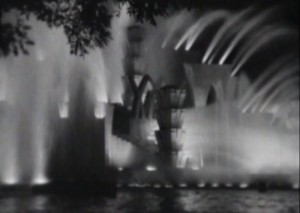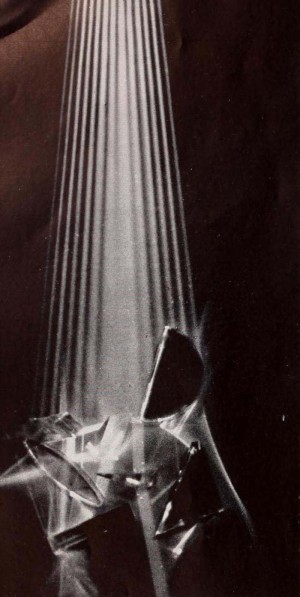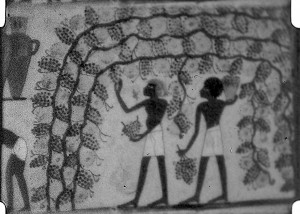
Luci di Parigi: da mattina a sera ed a notte = Lights of Paris: from morning to evening and at night.

"The Eyes Of Science, 3000 ft., 35mm., planned and photographed by J. S. Watson, Jr. and Melville Webber, is exceptional for continuity treatment and photography alike. Conceived primarily as an industrial film of a very high order, the final result is a veritable tour de force in the technical accomplishment of film exposition. Telling the story of lens making and culminating in representation of the impressive and complicated optical machinery which plays an important part in modern art and industry, the smoothness of the continuity is plainly the result of careful calculation of the interest value of the whole as well as of every small part. Multiple exposures, lap dissolves, color and microcinematography, as well as a number of surprising photographic effects, give this film a technical interest much above the average. Of these, some of the exceptional examples are the photography of light rays passing through prisms and lenses; a recording of the phenomenon of Newton's Rings in color; a scene showing a subject, together with its image on the ground glass of a camera; strains in a structure revealed by polarized light and many other remarkable shots. In short, the combination of cinematic art and skill with which this film is composed places it well in the front rank of all existing industrials regardless of the source of their production." Movie Makers, Dec. 1931, 657.
"Made in collaboration with Melville Webber for Bausch & Lomb Optical Co. Included: glass making, grinding, and polishing lenses and prisms, manufacture and principles of operation of microscopes, telescopes, and other optical instruments" (Unseen Cinema, 114).
"The Toilers, a 150 ft. Kodacolor reel made by Arthur G. Greaves, demonstrates the continuity possibilities of Kodacolor, a much neglected aspect of amateur color movies. Men at work — in the harbors, along the seacoast and inland, caring for flocks and harvesting grain — is the motif of the picture, relieved by a few glimpses of men and children at play. The picture is distinguished by beautiful photography of consistent quality and by a smooth succession of moving compositions in color. These qualities, combined with a clear continuity, give the film much more unity than is usual with Kodacolor reels. This is one of the all too few Kodacolor films that may be viewed as a subject possessing an artistic purpose as a whole, rather than as a series of separate scenes and sequences. Its chief color triumph is, perhaps, in the scenes of the harvesting against the background of fields of golden grain." Movie Makers, Dec. 1931, 658.

"The Tombs Of The Nobles, 400 ft., 16mm., is distinguished both in its subject matter and technical triumph over seemingly insuperable photographic odds. In it Mr. Hansen has achieved a clear and valuable record of Egyptian art and history as he found them presented on the interior walls of countless Egyptian tombs. Only by a careful placing and manipulation of sheets and mirrors in the cramped space of each tomb was Mr. Hansen able to cast sufficient light from the doorways onto the hundreds of paintings which he photographed. The film's continuity has been planned and edited in a simple, documentary style, adapted for use as an informal lecture subject. Its technical accomplishment seems unparalleled in the annals of amateur filming and has been well employed in recording subject matter entirely different from the general amateur picture." Movie Makers, Dec. 1931, 658.
"The Wonder Trail, 1000 ft., 35mm., filmed by Ralph C. Wildes, has also met with the approval of professional critics, for it has been released as a professional short subject and has received general praise. One reviewer wrote, "The Wonder Trail is an unforgettable picture; the restful, sheer beauty of it is an experience in entertainment." This is high praise, indeed, for an amateur picture since it must be remembered that the reviewer was comparing it with the hundreds — even thousands — of professional short subjects released each year. It is a scenic built from sequences of the Grand Canyon, Yosemite and the Redwood forests of California. Its photography is superlatively good and rare artistic judgment was exercised in the selection of camera viewpoints to effect beautiful compositions and to emphasize the dramatic value of mountains, falls and trees. The quality of the film's continuity lies in the leisurely sequences which display skill and care in both planning and editing." Movie Makers, Dec. 1931, 658
"Stephen F. Voorhees's 400 ft. travel film of Italian architectural scenes deserves placement in this list because it combines three factors but rarely brought together in pictures of this type. First, the photography is extraordinarily good, not only with reference to the routine requirements of exposure and focus but because it is artistic throughout and the composition never descends to the casual or the "snap shot" level. Second, Mr. Voorhees's film has a natural and easy continuity, jogging amiably through Venice and its environs, much as a traveler might do himself, pausing for a bit of incidental human interest and catching a scene that the filmer felt was unusual but presenting it without any preliminary flourishes, as one friend who might have said to another in the course of a stroll, "Don't miss that, by the way," pointing to something seen on the way. Last of the three things, so unusual to find combined, is a professional study, made by the filmer, himself a great architect, preserving those details which he wished to bring from northern Italy for later possible use. The great Colleoni statue is studied from many angles. Details of tiles and other wall ornamentations are offered and buildings are presented from one viewpoint after another. Yet all of this is done unpedantically and the nonprofessional audience is not aware that this subtle architectural record is more than a delightful travel film." Movie Makers, Dec. 1931, 658.
Total Pages: 299